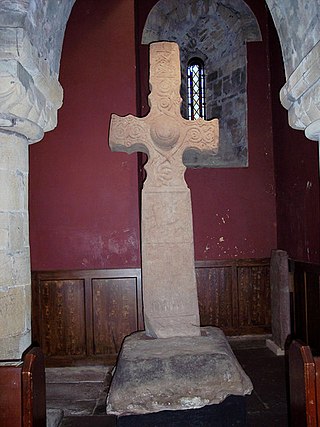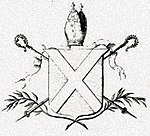Related Research Articles
Causantín mac Cináeda was a king of the Picts. He is often known as Constantine I in reference to his place in modern lists of Scottish monarchs, but contemporary sources described Causantín only as a Pictish king. A son of Cináed mac Ailpín, he succeeded his uncle Domnall mac Ailpín as Pictish king following the latter's death on 13 April 862. It is likely that Causantín's reign witnessed increased activity by Vikings, based in Ireland, Northumbria and northern Britain. He died fighting one such invasion.
Domnall mac Causantín, anglicised as Donald II, was King of the Picts or King of Alba in the late 9th century. He was the son of Constantine I. Donald is given the epithet Dásachtach, "the Madman", by the Prophecy of Berchán.
Óengus mac Fergusa was king of the Picts from 820 until 834. In Scottish historiography, he is associated with the veneration of Saint Andrew, the patron saint of Scotland. Although, this has not been proven.

Causantín or Constantín mac Fergusa was king of the Picts, in modern Scotland, from 789 until 820. He was until the Victorian era sometimes counted as Constantine I of Scotland; the title is now generally given to Causantín mac Cináeda. He is credited with having founded the church at Dunkeld which later received relics of St Columba from Iona.
Fergus mac Echdach was king of Dál Riata from about 778 until 781.
Áed Find, or Áed mac Echdach, was king of Dál Riata. Áed was the son of Eochaid mac Echdach, a descendant of Domnall Brecc in the main line of Cenél nGabráin kings.
The House of Alpin, also known as the Alpínid dynasty, Clann Chináeda, and Clann Chinaeda meic Ailpín, was the kin-group which ruled in Pictland, possibly Dál Riata, and then the kingdom of Alba from the advent of Kenneth MacAlpin in the 840s until the death of Malcolm II in 1034.

The Kingdom of Alba was the Kingdom of Scotland between the deaths of Donald II in 900 and of Alexander III in 1286. The latter's death led indirectly to an invasion of Scotland by Edward I of England in 1296 and the First War of Scottish Independence.
Conall mac Taidg was a king of the Picts from 785 until 789. Very little is recorded of Conall. He is mentioned twice by the Irish annals, the most reliable source for the history of northern Britain in the years around 800. He also appears in later king lists.
Alpín son of Uuroid was king of the Picts from 775 until 778.
Ciniod, Cináed or Cinadhon, son of Uuredech, was king of the Picts from 763 until 775.

The origins of the Kingdom of Alba pertain to the origins of the Kingdom of Alba, or the Gaelic Kingdom of Scotland, either as a mythological event or a historical process, during the Early Middle Ages.
Fothad I is the second alleged Bishop of the Scots (906x955). We know he had the status of "bishop" during the reign of King Dub mac Maíl Coluim because the Chronicle of the Kings of Alba has his death in the period of his reign (962-967). Such a date is supported by the Irish annals, and according to the Annals of the Four Masters, he died in 963. According to the latter source, he was Fothadh, mac Brain, scribhnidh & espucc Insi Alban; that is, "Fothad, son of Bran, scribe and bishop of the islands of Scotland". This entry taken on its own obviously places some doubt on his status as a bishop of St Andrews. It is only because he is mentioned as a bishop of St. Andrews in the bishop-lists of Walter Bower and Andrew of Wyntoun that he is identified with this see; however no pre-15th century sources actually confirm this, although it is true that there was definitely a bishop of this name in the 11th century. Bower, however, gives some explanation, telling us that Fothad "was driven out by King Indolff; and after his expulsion from the see he lived for 8 years". This Indolff, or King Idulb mac Causantín reigned between 954 and 962. If we take both Bower's statement and the obit reported in the Annals of the Four Masters to be correct, this means that Fothad was expelled in 955. Although it is unlikely anyway, he could not have been bishop before the year 906, when we know his predecessor Cellach was still bishop. That he died in 963 as "espucc Insi Alban" allows the possibility that he transferred his see to Iona or elsewhere on the western coast of Scotland after 955, although this is just conjecture.
Máel Ísu I is the third alleged Bishop of Cennrígmonaid, equivalent to latter day St Andrews. He is mentioned in the bishop-lists of the 15th-century historians Walter Bower (Malisius) and Andrew of Wyntoun (Malice) as the successor of Fothad I, and it is claimed that he reigned as bishop for eight years. If Máel Ísu's predecessor did get expelled from the bishopric in 955,, and if Máel Ísu's reign really was eight years, then Máel Ísu would have held the bishopric between the years 955 and 963.
Cellach II is the fourth alleged Bishop of the Scots, the predecessor of the later St Andrews bishopric.
Áed mac Boanta is believed to have been a king of Dál Riata.
Domnall mac Caustantín is thought to have been king of Dál Riata in the early ninth century.
Donncoirce was probably king of Dál Riata until his death in 792.
References
- Anderson, Alan Orr (1922), Early Sources of Scottish History A.D. 500 to 1286, I (1990 revised & corrected ed.), Stamford: Paul Watkins, ISBN 1-871615-03-8
- Broun, Dauvit, "Dunkeld and the origin of Scottish identity", in Innes Review 48 (1997), pp. 112–124, reprinted in Spes Scotorum: Hope of Scots, eds. Broun and Clancy (1999), pp. 95–111.
- MacQueen, John, MacQueen, Winifred & Watt, D.E.R. (eds.), Scottichronicon by Walter Bower in Latin and English, Vol. 3, (Aberdeen, 1995)
- Miller, Molly, "The Last Century of Pictish Succession", in Scottish Studies, 23, 1979, pp. 39–67
